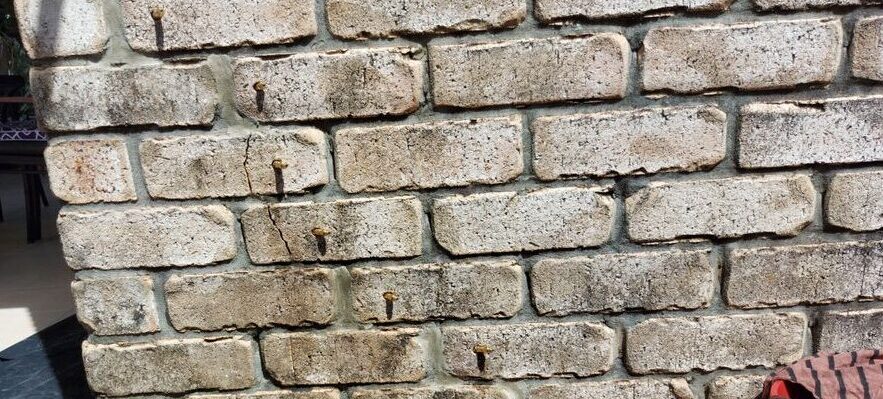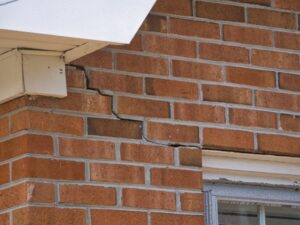
21 Mar Buildings are cracking – Going from wet to dry weather
Subscribe to our newsletter
What role does the change between La Niña (wet climate) and El Niño (dry climate) have on the formation of cracks in concrete constructions?
- The 2022-23 La Niña has ended, returning to ENSO-neutral.
- International model forecasts suggest a high chance of El Niño being declared later in 2023.
- We may say goodbye to frequent rain events as El Niño delivers a drier climate.
- El Niño => drier climate => sinking and shifting foundations
Going from heavily saturated soil to dry soil again
The Australian landscape water balance in QLD and NSW has been very much above average in the last couple of years. That is now changing with decreasing rainfall.
Do you remember the last drought season? The prolonged hot and dry weather depleted reactive clay soils of moisture and caused cracks to appear in many buildings. It saw property owners spend tens of thousands of dollars on underpinning and other repair work to major cracks, some of which were wide enough to let in the daylight.
Many structural engineers’ reports attributed structural cracks to the drought and nearby trees for taking moisture away from the foundations. With persistent low rainfall water restrictions follow, and combined they change the ground moisture levels dramatically.
Why are buildings vulnerable to cracking when moisture-laden reactive soil dries out?
- Wet seasons cause reactive soils to become saturated quickly as it drains poorly. When reactive soils become wetter, they lift.
- Dry seasons cause reactive soils to dry out. When they become dry, they drop.
- The resulting sudden volume changes and movement in the soil can shift a building’s foundation.
- Exposed soil dries faster than the covered soil under the foundation. Exposed soil as well as thirsty trees nearby may draw moisture from the transition zones which can cause a differential settlement. An uneven movement of the building can cause cracking due to an immense strain on the structure, especially building elements like concrete and bricks which have limited tensile strength.
Many buildings in Queensland and New South Wales (commercial, industrial, civil and residential) are situated on what is termed reactive soils. These are typically clay-type soils, which are dense and fine-grained in material making them sensitive to moisture changes and subject to expansion and contraction both horizontally and vertically. Buildings built in areas of reactive clay-type soils are often experiencing foundation settlement related problems.
An even settlement of the foundation structure is usually considered normal and acceptable. Minor settlement cracks are unlikely to affect the structural integrity of your concrete structural elements and can easily be fixed by using a suitable filler and Waterstop Solutions‘ proprietary injection systems to repair and provide localised crack reinforcement. These systems also prevent water ingress through the crack while protecting reinforcement from oxidization/rusting.
Possible signs of foundation settlement issues
- Diagonal or zigzag cracks on walls.
- Step cracks in the brick facade that travel up to the roof line.
- May be able to see the crack from both the inside and the outside of the property.
- Cracks caused by subsidence will often be diagonal and tend to be wider at the top than at the bottom.
- Gaps or separation of the exterior trim.
- The roofline is no longer straight and even.
- Warped ceiling.
- Bouncy, buckling and creaking floor.
- Gaps in areas where the floors, walls, and ceilings meet.
- The wall separating from indoor cabinets.
- Movement of wood trim and other inside fixtures.
- Doors or windows sticking or not opening and closing correctly.
- Another subtle sign of foundation problems is cracking around window frames, particularly at the top, and around doorways, especially above the top trim.
 Matt Cornell, the director of Cornell Engineers, provides responses to 6 questions related to ground movement and cracks in buildings.
Matt Cornell, the director of Cornell Engineers, provides responses to 6 questions related to ground movement and cracks in buildings.
- What role does the change between saturated soil and dry soil have on the formation of cracks in concrete constructions?
Fine-grained soils shrink as they dry out, and this reduction in volume can cause differential subsidence of the ground beneath and the ground surrounding a structure. The soil around the building tend to dry out quicker, especially if there are thirsty trees near the building. This non-uniform settling can lead to the development of cracks with varying degrees of significance.
Changing from dry soil to wet soil, however, could affect concrete construction in the following ways.
- Cracks become more visible when concrete leaks. Signs include damp patches, rust stains, efflorescence and weeping walls and damp spaces.
- Saturated soil outside a basement has less strength and places larger lateral forces on a basement wall. In addition to the extra force from hydrostatic pressure these forces increase the risk of near-side cracking if the wall has not been appropriately reinforced.
- An inappropriately waterproofed wall goes from performing acceptably to performing poorly in the eyes of the user. (i.e. non-liveable areas do not necessarily need to be waterproof).
- In multilevel concrete buildings, what are the top 5 signs of a shift in the building’s foundation? And what are your recommendations to rectify, if deemed necessary?
The foundation of a multilevel concrete building should be engineer-designed and closely supervised. I’d like to believe that these foundations do not shift but obviously they do.
- Uneven movement between a basement slab and the perimeter walls/internal columns.
- Diagonal cracking in reinforced concrete masonry and reinforced concrete walls.
- Cracking in the wall to suspended concrete connections – especially at the top of a wall and in the soffit of the concrete adjacent to the wall.
- Jamming and sticking roller shutters and garage doors.
- Basement slab drainage not working – water flowing away from drains and ponding in areas where it never used to pond.
- Do cracks indicate a structural problem?
It depends. A lot of factors must be considered when determining if a crack is a structural problem. The width of the crack, the location of the crack, the direction of the crack, the substrate, and the presence of crack control measures such as control joints. Diagonal cracks in walls, as an example, can indicate a structural problem.
- How much wall cracking is acceptable?
It depends on the application, the finish, the location (basement or lounge room) and the user’s acceptance of cracks. Many fine cracks could be seen to be as bad as one or two large cracks. Some concrete surfaces could be severely cracked and still considered useable.
- How can you prevent cracks from getting worse?
With the exception of shrinkage cracks or spalling from corroding reinforcement, cracks are an indication of movement generally caused by something changing, the ground, or the amount of water in the soil. The solution is to identify the cause of the crack and reverse or halt that change. Actually, spalling reinforcement and corrosion cracks also require that change to be halted and perhaps repaired.
- When do you consider a crack too big to be repairable?
Almost never. Crack width wouldn’t be a major factor in repairability, but the method might change, the cost of the work will change and the risk of the damage reappearing or appearing elsewhere is a factor. Eventually, with those elements considered rebuilding could become more economical instead of repairing. For example, if a wall has been built so badly that the expectation is that it will need to be repaired regularly at 6 monthly intervals then that damage is too much to repair and the job becomes a replacement job.
What can be done to rectify and who can help?
If you are concerned about a crack in your building and its impact, our recommendation is to seek professional advice on whether the crack is of a structural nature before undertaking any major works. It is important to assess the crack, identify the cause and determine the correct repair methods to rectify the source of the issue. Serious cracking might need some structural repair.
- Identify the root cause and repair method – Seek advice from an experienced structural engineer. (Cornell Engineers)
- Stabilise and support – Seek advice from a foundation repair specialist. (Foundation Solutions)
- Seal to reinforce, strengthen and protect the crack’s area from water ingress and oxidization – Ask us about Waterstop Solutions’ proprietary crack injection system.
AS 2870 for residential slabs and footings suggests cracks greater than 1mm may need remediation. QBCC also suggest of remediation of cracks in masonry walls between 1-5mm (https://www.qbcc.qld.gov.au/sites/default/files/documents/guide-standards-tolerances.pdf). At Waterstop Solutions we frequently observe that cracks measuring around 0.3mm in width carry a potential risk for water ingress, which may lead to further problems.
Structural Engineer – Cornell Engineers
If you notice any cracks wider than 2mm, with a zigzag or diagonal shape or visible both inside and outside your property, we strongly recommend seeking advice from an experienced and reliable structural engineer to determine the underlying cause.

Foundation Solutions Underpinning
Where a structural engineer has recommended foundation repairs to the buildings, we recommend seeking advice from an expert foundation repair professional such as Foundation Solutions Underpinning.

The foundations of a building are an integral structural element of any building and therefore require proper support. At Foundation Solutions, we recommend solutions only when they are deemed appropriate by a qualified engineer. Foundation Solutions never advocate for solutions that are not the right fit, Nicole says. www.foundationsolutions.com.au
Waterstop Solutions – To strengthen, protect, and avert further deterioration with Waterstop Solutions Proprietary Injection System
Once the source of the cracking has been resolved, we recommend sealing the crack with Waterstop Solutions’ proprietary Injection Systems. These systems provide an economical and effective solution to reinforce the structural integrity of walls, columns, and slabs by fusing the crack together while also providing protection against water infiltration when it rains.
The leak sealing and concrete repair specialists of Waterstop Solutions are highly trained in executing the injection process, which produces a continuous three-dimensional seal embedded in the concrete. This technique is composed of a combination of proprietary methods developed and perfected over thousands of projects.
Waterstop Solutions’ proprietary injection system exceeds the highest injection process and safety standards in Australia and internationally throughout Europe and the USA.
Book an inspection today
Give Waterstop Solutions a call today if you need assistance and repairs done. We can help with inspection, provide you with tailored solutions for remedial works such as slab jacking, ground improvement, leak sealing injections, waterproof membrane refurbishment and concrete defect repairs for multistory buildings, and commercial, industrial and civil sites.
Waterstop Solutions’ inspectors are equipped with extensive industry knowledge and the latest in non-invasive inspection technologies. Our thorough site assessment and diagnosis process provides our clients with industry-leading, expert advice. Following an inspection, our specialist staff formulate a free, comprehensive quotation including recommendations tailored to the assessed concerns, which is then emailed to you in a timely manner.
Audit and Priority Report Service for concrete structures
In addition to our regular inspection service, we can provide Audit and Priority Report Services for concrete structures. We carry out audits of waterproofing and concrete defects in concrete multi-storey buildings, industrial sites, warehouses, and larger water infrastructure sites.
The audit consists of a defect information list of items classed in priorities from P1 to P4, and their repair types. Ask us about how to secure a booking for this additional service.
Contact our team today
Brisbane office: (07) 3205 1899
Email: [email protected]
Sydney office: (02) 9346 8308
Email: [email protected]
Are you interested in finding out more about the various remedial building services we are providing?
Please click on the image below to download Waterstop Solutions Capability Statement
Waterstop Solutions Capability Statement is now available to download as PDF. (The image is clickable and opens up a link to our Capability Statement).



